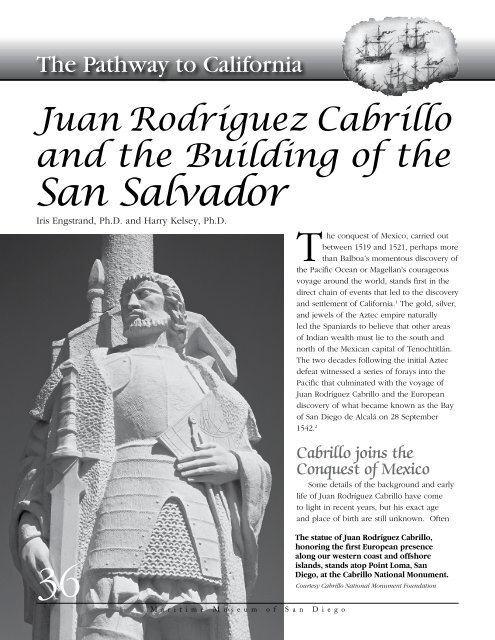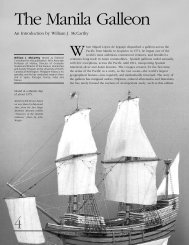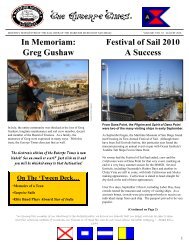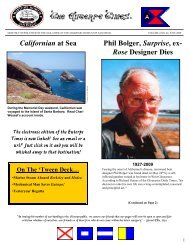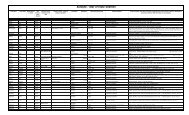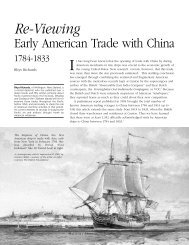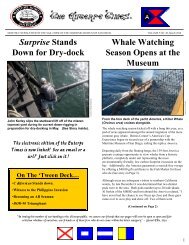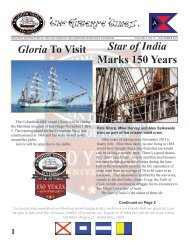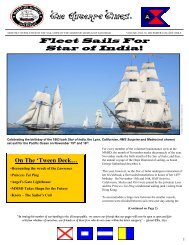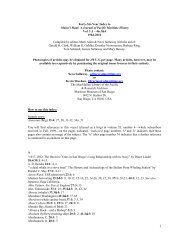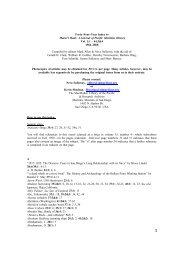Juan RodrÃguez Cabrillo And The Building Of The San Salvador
Juan RodrÃguez Cabrillo And The Building Of The San Salvador
Juan RodrÃguez Cabrillo And The Building Of The San Salvador
You also want an ePaper? Increase the reach of your titles
YUMPU automatically turns print PDFs into web optimized ePapers that Google loves.
<strong>The</strong> Pathway to California<br />
<strong>Juan</strong> Rodríguez <strong>Cabrillo</strong><br />
and the <strong>Building</strong> of the<br />
<strong>San</strong> <strong>Salvador</strong><br />
Iris Engstrand, Ph.D. and Harry Kelsey, Ph.D.<br />
<strong>The</strong> conquest of Mexico, carried out<br />
between 1519 and 1521, perhaps more<br />
than Balboa’s momentous discovery of<br />
the Pacific Ocean or Magellan’s courageous<br />
voyage around the world, stands first in the<br />
direct chain of events that led to the discovery<br />
and settlement of California. 1 <strong>The</strong> gold, silver,<br />
and jewels of the Aztec empire naturally<br />
led the Spaniards to believe that other areas<br />
of Indian wealth must lie to the south and<br />
north of the Mexican capital of Tenochtitlán.<br />
<strong>The</strong> two decades following the initial Aztec<br />
defeat witnessed a series of forays into the<br />
Pacific that culminated with the voyage of<br />
<strong>Juan</strong> Rodríguez <strong>Cabrillo</strong> and the European<br />
discovery of what became known as the Bay<br />
of <strong>San</strong> Diego de Alcalá on 28 September<br />
1542. 2<br />
<strong>Cabrillo</strong> joins the<br />
Conquest of Mexico<br />
Some details of the background and early<br />
life of <strong>Juan</strong> Rodríguez <strong>Cabrillo</strong> have come<br />
to light in recent years, but his exact age<br />
and place of birth are still unknown. <strong>Of</strong>ten<br />
36<br />
<strong>The</strong> statue of <strong>Juan</strong> Rodríguez <strong>Cabrillo</strong>,<br />
honoring the first European presence<br />
along our western coast and offshore<br />
islands, stands atop Point Loma, <strong>San</strong><br />
Diego, at the <strong>Cabrillo</strong> National Monument.<br />
Courtesy <strong>Cabrillo</strong> National Monument Foundation<br />
Maritime Museum of <strong>San</strong> Diego
Harry Kelsey is the former chief curator of history at the Natural History Museum<br />
of Los Angeles County and currently a research scholar at the Huntington library.<br />
He is the author of several books including <strong>Juan</strong> Rodríguez <strong>Cabrillo</strong>, <strong>The</strong> Doctrina<br />
and Confesionario of <strong>Juan</strong> Cortés, Frontier Capitalist: <strong>The</strong> Life of John Evans and<br />
Sir Frances Drake: <strong>The</strong> Queen’s Pirate.<br />
Iris Engstrand, Professor of History at the University of <strong>San</strong> Diego, specializes<br />
in the history of Spain, Spanish California, and early exploration of the Pacific<br />
Ocean. Her research interests range from Spain’s role in the eighteenth century<br />
scientific enlightenment to <strong>San</strong> Diego’s modern history. Among her publications<br />
are Spanish Scientists in the New World (1981); <strong>The</strong> <strong>San</strong> Diego Yacht Club: A<br />
History (with Cynthia Dávalos, 2000) and <strong>San</strong> Diego: California’s Cornerstone<br />
(1981, 2005). She serves as a trustee of the Maritime Museum of <strong>San</strong> Diego and<br />
as co-editor of <strong>The</strong> Journal of <strong>San</strong> Diego History.<br />
described as “a Portuguese navigator sailing under the flag<br />
of Spain,” his career seemed to begin on the California coast.<br />
<strong>Cabrillo</strong>’s original journal of exploration has not been found,<br />
but other documents, including a later copy of a journal, are<br />
housed in the Archives of the Indies in Seville. Documents<br />
in the Royal Audiencia in Guatemala give information about<br />
<strong>Cabrillo</strong>’s service to Spain, family and estates in Guatemala,<br />
and activities in California. His surname, which in its<br />
correct form would be Rodríguez or Rodríguez <strong>Cabrillo</strong>,<br />
adds confusion to his nationality. If he were Portuguese,<br />
his complete name would be João Rodrigues Cabrilho, but<br />
he always signed himself <strong>Juan</strong> Rodríguez in the Spanish<br />
way. <strong>Cabrillo</strong>, a Spanish surname, is unknown as a surname<br />
in Portugal, although there are several Portuguese villages<br />
called Cabril, from which the name might have been<br />
derived, and which claim <strong>Juan</strong> Cabrilho as their own.<br />
For the past century or so, a few writers have said<br />
he was Portuguese, but most historians now think this<br />
is an error. 3 <strong>The</strong> government, his family, his friends,<br />
and even his enemies treated him as though he were<br />
Spanish. Probably <strong>Cabrillo</strong> himself did not know who his<br />
parents were or exactly where they came from. Certainly he<br />
never mentioned their names in any official documents, as<br />
men were obliged to do when they gave sworn testimony.<br />
<strong>Cabrillo</strong>’s great grandson later said under oath that Above: From Spanish chronicler Antonio de Herrera<br />
y Tordesillas’ Historia General de los hechos de los<br />
his illustrious ancestor came from Spain. 4 <strong>Cabrillo</strong>’s<br />
Castellanos en las Islas y Tierra Firme del Mar Oceano<br />
friend Pedro de Ovid swore that he knew this was (4 volumes), in which he mentions “<strong>Juan</strong> Rodríguez<br />
true, because he came with him in the army of Pánfilo de <strong>Cabrillo</strong> Portugues,” in his historical account written<br />
Narváez. Even so, many people accept the statement of the more than half a century after the explorer died.<br />
Spanish chronicler Antonio de Herrera, who wrote more<br />
Herrera’s statement is at odds<br />
with modern historians’ accounts.<br />
37<br />
than half a century after the explorer died. Herrera placed Courtesy José Maria Gaztelú,<br />
the word or name “Portugues” in his text. 5<br />
Private Collection, Pamplona, Spain<br />
S a n S a l v a d o r
<strong>Cabrillo</strong>’s Life<br />
in the New World<br />
<strong>The</strong> record of <strong>Juan</strong> Rodríguez <strong>Cabrillo</strong>’s life begins<br />
in <strong>San</strong>to Domingo in 1510 when, at the age of<br />
twelve, he landed in the New World. He later<br />
reached the Mexican coast as a crossbowman with the<br />
Pánfilo de Narváez expedition sent out by Governor<br />
Diego de Velásquez of Cuba to arrest and return Cortés<br />
to Cuba prior to his march against the Aztecs. 6 <strong>The</strong><br />
Narváez expedition arrived too late to interfere with the<br />
siege of Tenochtitlán. Hearing of the governor’s plan,<br />
Cortés left part of his army inside the Mexican capital<br />
under his second-in-command Pedro de Alvarado and<br />
returned to Vera Cruz to face the threat from his home<br />
base. Defeating the newly arrived Spanish force in a<br />
surprise move, Cortés won the Narváez soldiers to his<br />
side with promises of gold, and prepared them to attack<br />
the Aztec island capital.<br />
<strong>Cabrillo</strong> thus became a part of Cortés’ reinforced army<br />
and, because Alvarado had failed to contain the Aztecs,<br />
served through the bloodiest battles of the conquest.<br />
<strong>Cabrillo</strong> was placed in charge of building watercraft<br />
(bergantines) to cross Lake Texcoco in order to attack<br />
the Aztec stronghold. Following the defeat of the Aztecs,<br />
<strong>Cabrillo</strong> accompanied Pedro de Alvarado on the conquest<br />
of Guatemala and took up residency there. Bernal Díaz<br />
del Castillo recorded that <strong>Cabrillo</strong> was a good soldier<br />
in the Mexican campaign . . . who later, as a resident<br />
of Guatemala, was a very honorable person, and<br />
was captain and admiral of thirteen ships on Pedro<br />
Alvarado’s behalf, and he served his majesty well in<br />
everything which presented itself to him . . . 7<br />
<strong>Juan</strong> Rodríguez, who did not begin to call himself<br />
<strong>Cabrillo</strong> until after 1536, first engaged in farming in<br />
Guatemala on the estates granted to him by Alvarado<br />
in August 1524. He prospered as a horseman and ranch<br />
owner and received permission to look for gold in<br />
1529. He and his friends Diego Sánchez de Ortega and<br />
<strong>San</strong>cho de Barahona discovered that native Guatemalans<br />
in Coban mined gold from the streams within land that<br />
<strong>Cabrillo</strong> controlled. Over the next few years, <strong>Cabrillo</strong><br />
heard tales of riches to the south in Peru, but in 1532<br />
preferred to sail east across the Atlantic to Spain. In<br />
38<br />
Seville, he courted and married Beatriz Sánchez de<br />
Ortega, the sister of his friend Diego and returned to<br />
Guatemala with his bride in 1533. <strong>The</strong> family settled on<br />
his vast estates, which by this time were producing corn,<br />
beans, and chile in addition to a cash crop of cacao. By<br />
1536, Beatriz gave birth to two sons who were baptized<br />
and confirmed in the cathedral church of <strong>San</strong>tiago. <strong>The</strong><br />
elder was named <strong>Juan</strong> Rodríguez <strong>Cabrillo</strong> while the<br />
younger was called Diego Sánchez de Ortega after his<br />
uncle. 8 <strong>Cabrillo</strong> was respected as a man of means—an<br />
hidalgo— and was involved in considerable business and<br />
domestic affairs in Guatemala prior to his association with<br />
California.<br />
Prelude to California:<br />
Cortés looks toward the Pacific<br />
By 1522 Hernán Cortés had reached the Pacific coast<br />
at Michoacán in central Mexico and founded the port city<br />
of Zacatula. He ordered construction of four ships for<br />
northward exploration, but a lack of supplies and skilled<br />
labor slowed progress. Essential European items such<br />
as ironwork and rigging had to be transported slowly<br />
overland from Vera Cruz. Four ships were nevertheless<br />
completed by 1527, just in time to comply with a royal<br />
order sending three of them to the Moluccas to strengthen<br />
Spanish claims in the East Indies. By that year the crown<br />
had established the Royal Audiencia, a judicial body that<br />
served as a court of appeals and, in the absence of an<br />
executive, as an administrative committee of government.<br />
It governed Mexican affairs until 1535, when the Kingdom<br />
of New Spain became a viceroyalty and was placed under<br />
Antonio de Mendoza, the first Viceroy of New Spain and<br />
personal representative of the king. Cortés resented this<br />
check on his authority and sought new lands to conquer.<br />
Exploring Baja California<br />
In his exploration of the Pacific, it is thought<br />
that Cortés hoped to find both the golden island of<br />
the Amazons and the long-sought Strait of Anián, or<br />
Northwest Passage to the Atlantic, lying somewhere<br />
to the north of the Mexican coast. Cortés outfitted two<br />
ventures in 1533 and 1534 that touched on the shores of<br />
Baja California. <strong>The</strong> survivors of the second expedition<br />
reported that the natives of their newly discovered island<br />
were primitive savages, but had collected an abundance<br />
Maritime Museum of <strong>San</strong> Diego
of pearls. Pearls alone gave<br />
Cortés sufficient incentive<br />
to plan his own expedition.<br />
He was joined by a rush<br />
of volunteers who knew<br />
the captain’s reputation for<br />
finding wealth.<br />
Three vessels reached the<br />
Bay of La Paz on 3 May 1535.<br />
Cortés named the “island”<br />
<strong>San</strong>ta Cruz and founded its<br />
first settlement on the dry,<br />
rocky coast. Native hostility<br />
and a lack of food made<br />
it necessary for two ships<br />
to return to the mainland<br />
for supplies – one of these<br />
was wrecked in the Gulf of<br />
California – then called the<br />
“Red Sea of Cortés.” On a<br />
second attempt to obtain<br />
supplies, only the ship that<br />
Cortés himself commanded<br />
made it back across the<br />
treacherous, stormy waters to La Paz. In the meantime,<br />
twenty-three of his men died of starvation on Baja<br />
California’s inhospitable shore. Cortés took the one<br />
remaining vessel and returned to Mexico to get further<br />
relief. Finally, toward the end of 1536, prospects of<br />
success seemed so remote that Cortés sent ships to pick<br />
up the surviving colonists. Thus ended the first in a long<br />
succession of attempts to settle California. 9<br />
<strong>The</strong> Ulloa Expedition<br />
In 1539 Cortés issued instructions to the final<br />
expedition that, under his direction, would pierce the<br />
mysteries of the north. His plans to return to Spain<br />
to solidify his territorial claims, however, kept Cortés from<br />
accompanying the voyage. Three vessels commanded<br />
by Francisco de Ulloa sailed from the port of Acapulco in<br />
July of that year; one, the tiny <strong>San</strong>to Tomás was wrecked<br />
in the stormy waters of the Gulf of California before<br />
reaching La Paz. Ulloa’s fleet, reduced to the l20-ton<br />
<strong>San</strong>ta Agueda and its flagship, the Trinidad, a 35- to 40-<br />
ton vessel not more than forty feet in length, left La Paz<br />
and headed across the choppy Red Sea of Cortés to the<br />
Above: This distinctive map titled ‘T Gebiedt van Guadalajara Niew<br />
Mexico en Californie enz (ca 1656-1665), by French cartographer<br />
Nicolas <strong>San</strong>son, supported the myth that California was an<br />
island – a misconception which continued well into the 1700s.<br />
MMSD Maps and Charts Collections<br />
mainland shore. Ulloa cruised northward to the port of<br />
Guaymas, which he named Puerto de los Puertos (the<br />
Port of Ports), and further on expected to find a passage<br />
around the “island” of California. Instead, the ships<br />
encountered violent tides caused by the Colorado River<br />
descending into the sea at the head of the narrow Gulf.<br />
<strong>The</strong> bleak shoreline, a lonely desert broken by stark<br />
mountains, offered few prospects for golden cities, so<br />
Ulloa turned southward, the first Spaniard to know that<br />
Baja California was not an island.<br />
<strong>The</strong> two vessels rounded Cabo <strong>San</strong> Lucas by the end<br />
of January 1540, and then sailed up the western shore<br />
as far north as the Isla de Cedros (Island of Cedars) so<br />
named because . . . on the tops of the mountains<br />
therein, there grows a wood of these Cedars<br />
being very tall, as the nature of them is to be. 10<br />
S a n S a l v a d o r<br />
39
Above: <strong>The</strong> map delineates<br />
what was known of the coast<br />
of New Spain (Mexico) and<br />
the peninsula of California<br />
prior to <strong>Juan</strong> Rodríguez<br />
<strong>Cabrillo</strong>’s voyage to Alta<br />
California. This copy of<br />
the original (now lost),<br />
was published in 1770<br />
by Francisco Antonio de<br />
Lorenzana in his Historia de<br />
Nueva España.<br />
Courtesy the Huntington Library<br />
40<br />
After three months, Ulloa sent the larger <strong>San</strong>ta Agueda home and<br />
continued his explorations northward in the Trinidad to perhaps Point<br />
<strong>San</strong> Antonio, just south of latitude 30 degrees. 11<br />
Ulloa’s revelation that Baja California was a peninsula aroused little<br />
attention and the “island” of California persisted on maps as late as 1784. 12<br />
His expedition, the last with which Cortés had any official connection,<br />
nevertheless, faced severe storms to explore both the eastern and western<br />
coasts of the peninsula. <strong>The</strong>ir discovery of an island of cedars compensated<br />
little for expected cities of gold. Disappointment was great and Cortés,<br />
angered at his lack of authority and frustrated by Viceroy Mendoza’s constant<br />
opposition, had sailed for Spain in 1540. Cortés argued his claims before<br />
the royal court, but his lawsuits dragged on before an unmoved officialdom.<br />
Years of effort gave him little satisfaction and finally, in 1547, death claimed<br />
the unhappy Cortés, first of the Spanish explorers to open the way to<br />
California. 13<br />
<strong>The</strong> Coronado Expedition<br />
While Ulloa’s voyage was still in progress, Viceroy Mendoza organized an<br />
ambitious, two-pronged land and sea expedition to find the fabulous Cíbola,<br />
Maritime Museum of <strong>San</strong> Diego
a city of gold somewhere in<br />
the interior of the continent.<br />
His intentions was to claim<br />
the area for Spain. Led by<br />
the able Francisco Vásquez de<br />
Coronado, the land procession<br />
was launched in February 1540<br />
from Compostela, near Tepic,<br />
with some 200 horsemen,<br />
seventy foot soldiers and nearly<br />
1,000 Indian allies and servants.<br />
For the sea detachment,<br />
three vessels commanded<br />
by Hernando de Alarcón left<br />
Mexico in May 1540 with<br />
instructions to explore the<br />
upper part of the Sea of Cortés<br />
and make overland contact with<br />
Coronado’s soldiers. During<br />
August and September, Alarcón<br />
explored the lower Colorado<br />
River, but a narrow canyon forced him to return downstream at a point south<br />
of Yuma, just short of touching California soil. Coronado’s expedition returned<br />
from its journey across the southwest without finding the alleged golden cities<br />
or other signs of Native American wealth. 14<br />
Viceroy Mendoza, disillusioned by the meager results of Coronado’s<br />
effort, resolutely turned to the sea with yet another plan to find the<br />
elusive Strait of Anián. Pedro de Alvarado, Governor and Captain-<br />
General of Guatemala, appeared at the port of Acapulco in 1540 with a<br />
fleet of thirteen vessels and offered his services to the crown for Pacific<br />
exploration. Close to Alvarado’s right hand during the conquest of Guatemala<br />
stood <strong>Juan</strong> Rodríguez <strong>Cabrillo</strong>, navigator, horseman, captain of crossbowmen,<br />
and shipbuilder. When Alvarado became captain-general of the province<br />
stretching from southern Mexico to the boundary of Panama, he named<br />
<strong>Cabrillo</strong> to construct a fleet of ships that he could sail across the Pacific to the<br />
Spice Islands.<br />
<strong>Building</strong> a Shipyard<br />
This seventeenth-century<br />
sketch illustrates the<br />
location of the shipyard<br />
at Girabaltique, a short<br />
distance up the river<br />
from the Guatemalan<br />
fishing village of Iztapa.<br />
From Harry Kelsey’s <strong>Juan</strong> Rodríguez<br />
<strong>Cabrillo</strong>, p. 69, plate 11.<br />
About fifteen leagues (35 miles) due south of <strong>San</strong>tiago, where the river<br />
Michatoya meanders into the Pacific Ocean, lay the sixteenth-century<br />
Guatemalan fishing village of Iztapa. Little more than an open roadstead and<br />
partially blocked by a huge sand bar, it was still the best seaport on the coast<br />
of New Spain. <strong>The</strong> shoreline was steep, the tides fast and strong, and the<br />
channel in a state of constant change during flood season. <strong>The</strong> anchorage was<br />
so hazardous that two ships from Alvarado’s first fleet were lost there during<br />
41<br />
the winter storms of 1533. 15 <strong>The</strong> evidence indicates that the main shipyard<br />
S a n S a l v a d o r
This woodblock sketch<br />
shows the method used by<br />
Guatemalan shipwrights to<br />
compute the proportions of<br />
a ship’s hull. <strong>The</strong> illustration<br />
is from the Instrucción<br />
náutica of Diego García de<br />
Palacio, who spent several<br />
years in Guatemala after the<br />
mid-sixteenth century.<br />
42<br />
was located at Girabaltique, a short distance up the river from Iztapa. <strong>The</strong>re<br />
was an abundance of good timber nearby, as well as pita fiber for making<br />
cables and rigging. Neighboring villages could provide food at low cost. 16<br />
Further down the coast in present-day El <strong>Salvador</strong> was another port,<br />
equally open to the weather. This was Acajutla, seaport for the cities<br />
of Trinidad and <strong>San</strong> <strong>Salvador</strong>. Acajutla featured a dangerous reef across<br />
the entrance to the bay, and ships stopped there only with great risk. Yet,<br />
interior roads to the coast were so poor that Acajutla was the only port where<br />
<strong>Salvador</strong>an cacao and other produce could be loaded for shipment to Peru<br />
and New Spain. In fact, this was the port where <strong>Juan</strong> Rodríguez <strong>Cabrillo</strong><br />
rigged and loaded his ship <strong>San</strong>tiago in 1534, just before Alvarado seized the<br />
vessel for his own use. 17 Some additional outfitting of the ships bound for the<br />
northwest seems to have been made there.<br />
Shipbuilding in the sixteenth century was more an art than a science.<br />
<strong>The</strong> outcome of any construction project depended as much on the skill and<br />
experience of the shipwrights and the availability of materials as on the wishes<br />
of the owner or designer. One ship captain complained that “some ships start<br />
in the yards as small ones and end as large ones, while others start as large<br />
ones and end up small.” 18 Ships were seldom built according to plan, and no<br />
two ships ever came out looking exactly alike. In Alvarado’s first fleet, one<br />
ship was a huge three hundred toneles, while the others were only half that<br />
size or less. 19<br />
<strong>Building</strong> a Fleet<br />
In order for <strong>Cabrillo</strong> to carry out his plans to build a new fleet, Indian<br />
cuadrillas, or work parties, were pressed into service, providing timber, iron,<br />
sails, cable, tar and pitch, and huge quantities of food for the shipwrights<br />
and those Africans and Indians engaged in producing raw materials. 20 It was<br />
difficult to keep the work running smoothly. Mayordomo (foreman) Alvaro de<br />
Paz found it to be nearly a full-time job locating and shipping the materials<br />
<strong>Cabrillo</strong> ordered for the project. Much of the timber was close at hand, but<br />
other supplies had to be brought from the interior provinces. Native workers<br />
were used to cut and trim timber, make pitch and rope, and work long hours<br />
to build the ships and galleys. 21<br />
Maritime Museum of <strong>San</strong> Diego
<strong>Of</strong> the thirteen ships that eventually made up the armada, only a part<br />
actually belonged to Alvarado. Several of the vessels were owned<br />
by other Spaniards who hoped to make money carrying supplies<br />
for the expedition and selling trade goods up and down the coast. <strong>Cabrillo</strong><br />
had built and owned his own vessel, named <strong>San</strong> <strong>Salvador</strong>, but usually called<br />
<strong>Juan</strong> Rodríguez. 22 <strong>The</strong>re is abundant evidence that sixteenth-century ships<br />
flew the banners and ensigns of their owners and their religious patrons.<br />
<strong>Cabrillo</strong>’s new ship “flew the banner of an almirante from the fore-topmast<br />
as almirantes of the sea are accustomed to do.” 23 <strong>The</strong> vessel also flew the<br />
arms of Alvarado and later those of Viceroy Mendoza. <strong>The</strong> religious banner<br />
probably showed a crucifix and perhaps the words <strong>San</strong> <strong>Salvador</strong>. 24<br />
When Alvarado returned from a trip to Spain in 1539, he brought with<br />
him a royal commission as well as huge supplies of sails, rigging, ironwork,<br />
anchors and other materials for the fleet. <strong>The</strong>se were landed at Puerto de<br />
Caballos on the Atlantic coast, and thousands of Indians were forced to build<br />
a road and carry supplies overland from the Atlantic to the Pacific. On his<br />
way home Alvarado stopped in <strong>San</strong> <strong>Salvador</strong> and reported to the historian<br />
Oviedo that he had built seven or eight ships on the Mar del Sur for a trip to<br />
the Spice Islands.” 25 <strong>The</strong> entire fleet eventually consisted of thirteen vessels,<br />
of which seven or eight were built by <strong>Cabrillo</strong> between 1536 and 1540.<br />
Although information is lacking on the exact details of the rigging, there<br />
is additional evidence about the rigging of the <strong>San</strong> <strong>Salvador</strong>. Luis González,<br />
a pilot on one of Alvarado’s vessels, later testified as follows: Johan R s<br />
<strong>Cabrillo</strong> went in his own ship which flew the banner of an almirante from<br />
its foretopmast . . . and this witness spoke with his pilot and knew it to<br />
be his ship. 26 Various references taken together generally meant that each of<br />
the ships, large and small alike, was square rigged. <strong>The</strong> foremast was rigged<br />
with a topmast. <strong>The</strong> mainmast, therefore, had to have a similar rig, and there<br />
must also have been a mizzenmast, perhaps with a lateen rig. 27 <strong>The</strong> twohundred<br />
ton <strong>San</strong> <strong>Salvador</strong> was therefore the almiranta, and then designated<br />
by the viceroy and probably by Alvarado as flagship of the armada that was<br />
to go up the Pacific Coast. 28 Later it would be La Capitana because it was<br />
commanded by <strong>Cabrillo</strong> as Captain General.<br />
Before the new armada left to sail up the coast of New Spain, <strong>Cabrillo</strong><br />
took the <strong>San</strong> <strong>Salvador</strong> on a trading voyage to Peru. Depending upon the<br />
cargo that the ship carried, which may have included valuable horses,<br />
<strong>Cabrillo</strong> could have earned enough to offset the cost of building the ship,<br />
which amounted to four thousand ducados. 29 <strong>The</strong> trip to Peru also gave<br />
<strong>Cabrillo</strong> a chance to train his crew and prepare himself for a longer voyage<br />
of exploration to the north. 30<br />
When the new fleet was ready to sail from Acajutla, Alvarado and<br />
Mendoza agreed that a new harbor was needed to serve as home port for the<br />
fleet. Consequently, they sent <strong>Cabrillo</strong> to look for a new site, and within a<br />
week or two, he discovered a fine port. 31 For a few days the place remained<br />
nameless, being called simply “the port of Colima.” Finally, Viceroy Mendoza<br />
43<br />
landed there with his own vessels on 25 December 1540, so the port was<br />
called Navidad in honor of the Nativity of Our Lord. 32<br />
S a n S a l v a d o r
125 120 115 110 105 100 95<br />
40<br />
40<br />
35<br />
35<br />
30<br />
30<br />
25<br />
Gulf of California<br />
New Spain<br />
(Mexico)<br />
25<br />
20<br />
Pacific Ocean<br />
20<br />
15<br />
125 120 115 110 105 100 95<br />
Noted are place names and locations<br />
which can be used as visual references<br />
for <strong>Cabrillo</strong>’s Voyage of 1542-1543.<br />
However, many of the place names were<br />
changed by the seventeenth-century<br />
Spanish explorer Sebastián Vizcaíno.<br />
Miscalculations in latitude also created<br />
confusion for historians and geographers<br />
trying to align historical and modern<br />
place names and locations.<br />
From An Account of the Voyage of <strong>Juan</strong> Rodríguez<br />
<strong>Cabrillo</strong> (<strong>San</strong> Diego, <strong>Cabrillo</strong> National Monument<br />
Foundation)<br />
44<br />
A Change in Plans<br />
Once there, plans for the destination of the armada were<br />
changed. Construction of Alvarado’s fleet had proceeded<br />
slowly as tools were scarce and <strong>Cabrillo</strong>, as master<br />
shipwright, insisted upon high standards of quality. When the thirteen<br />
ships were finally completed in 1540, Alvarado asked <strong>Cabrillo</strong> to join<br />
the expedition in his own <strong>San</strong> <strong>Salvador</strong> as admiral of the entire fleet.<br />
By this time, however, Viceroy Mendoza and Pedro Alvarado<br />
had entered into a partnership, agreeing to share profits from the<br />
viceroy’s overland expeditions and Alvarado’s own expeditions to the<br />
Spice Islands. <strong>The</strong>y planned to divide the fleet into two parts, one to<br />
Maritime Museum of <strong>San</strong> Diego<br />
15
investigate islands as far west as the East Indies,<br />
and the other to explore the North American<br />
Pacific coast “until its end and secret were sighted.”<br />
Just before departure, however, Alvarado left his<br />
ships in charge of <strong>Cabrillo</strong> while he helped the<br />
viceroy put down an Indian uprising known as the<br />
Mixton War. This battle, in 1541, ironically cost<br />
Alvarado his life-– he was crushed to death under a<br />
falling horse. 33<br />
<strong>The</strong> untimely death of Alvarado created new<br />
problems and delays. <strong>Cabrillo</strong> returned<br />
to Guatemala, taking some of the ships<br />
with him. On the morning of 11 September 1541,<br />
only a few days after he had arrived, a devastating<br />
earthquake hit <strong>San</strong>tiago. Rain had drenched the<br />
land for days, and the earthquake sent tons of mud<br />
streaming down the side of a volcano overlooking<br />
the town. <strong>Cabrillo</strong> hurried to <strong>San</strong>tiago from<br />
Acajutla to find his home destroyed but his family<br />
unharmed. He spent the next several months<br />
building a home in the new capital, now called<br />
Antigua, and getting his family settled in their new<br />
surroundings. <strong>Cabrillo</strong> later wrote an account of the<br />
earthquake and the damage it had caused, signing<br />
it as <strong>Juan</strong> Rodríguez, Escribano (Notary Public). 34<br />
In the meantime, Viceroy Mendoza took possession<br />
of Alvarado’s fleet and, showing high regard for <strong>Cabrillo</strong>,<br />
commissioned the Guatemalan captain general to<br />
continue the voyage northward along the Pacific Coast<br />
in search of the Strait of Anián. His fleet would consist of<br />
his own <strong>San</strong> <strong>Salvador</strong>, a galleon of about 125 by 25 feet,<br />
and La Victoria, a cargo ship of about 80 feet in length.<br />
<strong>The</strong> <strong>San</strong> Miguel, a small 30-foot vessel (fragata) suited<br />
for coastal duties, seems also to have been destined to<br />
accompany the expedition.<br />
<strong>Cabrillo</strong>’s expedition did not set sail from the Port<br />
of Navidad until 27 June 1542, with two and probably<br />
three of the vessels of Alvarado’s former fleet to explore<br />
the remote, uncharted areas of the North Pacific. <strong>The</strong><br />
remaining vessels were dispatched to the Philippines<br />
under the viceroy’s cousin Ruy López de Villalobos. 35<br />
<strong>Cabrillo</strong>’s goal, one that had inspired Cortés before him,<br />
was to find the Northwest Passage and a shortcut to<br />
Oriental riches. <strong>The</strong> potential rewards propelled <strong>Cabrillo</strong><br />
and his fellow adventurers into unknown waters further<br />
to the north than any yet sailed by European ships.<br />
Above: On 11 September 1541, the city of <strong>San</strong>tiago<br />
was devastated by an earthquake. A report of<br />
the earthquake was written by “ <strong>Juan</strong> Rodríguez,<br />
Escribano.” <strong>The</strong> earliest secular publication known<br />
to have been published in the New World was called<br />
Relacíon del espantable terremoto que agora nuevamente<br />
acontecído en las yndias en una ciudad llamada Guatimala.<br />
From the Real Biblioteca de <strong>San</strong> Lorenzo de El Escorial, Spain<br />
Sources for the Name<br />
of California<br />
<strong>The</strong> <strong>San</strong> <strong>Salvador</strong> and La Victoria cruised northward<br />
along the west coast of Mexico, crossed the Sea of Cortés,<br />
and proceeded up the Pacific side of what <strong>Cabrillo</strong> knew<br />
as the California peninsula. <strong>The</strong> name California was<br />
already in use by 1542, but its first application, and by<br />
whom, remains a mystery. It came into existence about<br />
the time of Ulloa’s expedition of 1539, but the exact time<br />
and, indeed, the exact reason for its appearance are still<br />
speculative. Most likely, the name was taken from the<br />
fictitious island of California featured by García Ordóñez<br />
de Montalvo in his novel Las Sergas de Esplandián<br />
45<br />
S a n S a l v a d o r
Maritime Museum of<br />
<strong>San</strong> Diego’s master<br />
ships’ artist, Richard<br />
DeRosset, portrays in his<br />
painting the approach<br />
of <strong>Cabrillo</strong>’s fleet to the<br />
port he would name<br />
Puerto de <strong>San</strong> Miguel.<br />
46<br />
published in 1508, which featured the beautiful Queen Calafia who ruled over<br />
her Island of California where Amazon women carried weapons made only<br />
of gold. 36<br />
<strong>The</strong> name California has also been attributed to other possible origins.<br />
It may have been a combination or derivation of Spanish or other<br />
European words. Cálida meaning hot or cal meaning limestone,<br />
may have been joined with forno (an old Castilian or Catalan form of horno)<br />
meaning oven, because the burning, desert lands of the peninsula resembled<br />
a hot oven, or the abundance of limestone suggested a lime-kiln. Further<br />
possibilities are kalifon, Hispano-Arabic for large province; Calafia a female<br />
form of Caliph; cala (Spanish for cove) and fornix (Latin for vault or arch);<br />
and finally, the name may have been chosen “because an Irishman, who was<br />
traveling, said that the island looked like the one where Calpurnius (Califurnio),<br />
the father of Saint Patrick was born.” 37 Until more definite proof of the word’s<br />
origin is found, all these choices have merit. Nevertheless, the name selected<br />
by Ordoñez for his island of Amazons located very near the Garden of Eden still<br />
holds the most widespread support.<br />
Maritime Museum of <strong>San</strong> Diego
<strong>Cabrillo</strong>’s ships entered the Bay of Ensenada, Baja California, on 17<br />
September 1542. <strong>The</strong> expedition remained in port five days and then<br />
continued on, covering from fifteen to twenty miles daily. Within three days<br />
they sighted the three Coronado Islands, called by <strong>Cabrillo</strong> Las Islas Desiertas<br />
(Deserted Islands) and placed at 34 degrees latitude (about 2 degrees too far<br />
north). From these waters the Spanish seamen noticed the smoke of coastal<br />
Indian fires and, as they approached the mainland, saw a promising green<br />
valley backed by high mountains. On 28 September 1542, the feast day of <strong>San</strong><br />
Miguel, <strong>Cabrillo</strong> headed the <strong>San</strong> <strong>Salvador</strong> and La Victoria into <strong>San</strong> Diego Bay,<br />
dropped anchor on the lee side of Point Loma, and formally discovered Alta<br />
(Upper) California – as distinguished from Baja (Lower) California. 38<br />
<strong>Cabrillo</strong>’s <strong>San</strong> Miguel<br />
<strong>The</strong> Spaniards stepped ashore and were greeted by friendly Indians<br />
whom <strong>Cabrillo</strong> described as “well built” and clothed in animal skins.<br />
<strong>The</strong> admiral bestowed the name of <strong>San</strong> Miguel Arcángel (St. Michael<br />
Archangel) upon his newly discovered “closed and very good port,” but it<br />
was changed sixty years later by Sebastián Vizcaíno, the Spanish navigator<br />
who chose to honor <strong>San</strong> Diego de Alcalá instead. Canonized as St. Didacus<br />
in 1588, Franciscan Brother Diego’s name had become popular in naming<br />
ships, forts, and ports during the early seventeenth century. Vizcaíno entered<br />
the bay in his flagship <strong>San</strong> Diego on 12 November 1602, the feast day of <strong>San</strong><br />
Diego de Alcalá. 39<br />
Three Indians timidly approached <strong>Cabrillo</strong>’s ship, indicating by signs<br />
that they knew of other similarly dressed white men, carrying crossbows<br />
and swords, traveling far inland. <strong>Cabrillo</strong> understood from their gestures<br />
that these strangers (probably a detachment from Coronado’s expedition)<br />
wielded lances from horseback and had killed many Indians. For this reason<br />
the California natives were afraid, but the Spaniards gave them presents and<br />
calmed their fears. When Indians wounded three seamen on a night fishing<br />
party near the shore, <strong>Cabrillo</strong> ordered his crew not to fire on them but to win<br />
their confidence. Spain’s first visitors to <strong>San</strong> Diego, called “Guacamal” by<br />
the natives, set a precedent of friendly treatment that was followed with few<br />
exceptions during the entire Spanish occupation of the territory. 40<br />
Sailing from <strong>San</strong> Diego after six days’ rest, the expedition sighted the<br />
Channel Islands of <strong>San</strong> Clemente and <strong>San</strong>ta Catalina. Since the harbor at <strong>San</strong><br />
Miguel had inadvertently been given the name of the smallest ship in the fleet,<br />
these two islands were named La Victoria and <strong>San</strong> <strong>Salvador</strong>, after the other<br />
two ships.<br />
<strong>Of</strong>f Catalina the Spaniards saw numerous Indians dancing and shouting on<br />
the shore, making signs for them to land and sending a canoe to approach the<br />
ships. When the sailors went ashore, some of the women ran away, though<br />
they quickly returned. After this, as the report has it, “<strong>The</strong>y felt very secure,<br />
the Spaniards, the Indian women, and everyone. 41 Though <strong>Cabrillo</strong> named the<br />
Island <strong>San</strong> <strong>Salvador</strong> and took formal possession in the name of the king, the<br />
47<br />
men of the fleet called the place Isla Capitana or <strong>Juan</strong> Rodríguez. 42<br />
S a n S a l v a d o r
Alta California<br />
Cabo (de <strong>San</strong>)<br />
Martin<br />
Cabo de Galera<br />
Point Conception<br />
<strong>San</strong> Francisco<br />
1 2 3<br />
Cabo de Pinos<br />
(Monterey Bay)<br />
4<br />
Channel Islands<br />
(modern names - historic names)<br />
1. <strong>San</strong> Miguel Island – La Posesión<br />
2. <strong>San</strong>ta Rosa Island – <strong>San</strong> Lucas<br />
3. <strong>San</strong>t Cruz Island – <strong>San</strong> Sebastian<br />
Limu<br />
4. <strong>San</strong>ta Catalina <strong>San</strong> <strong>Salvador</strong><br />
La Capitana<br />
La Posesión<br />
Pueblo de las Canoas (Ventura)<br />
Bahía de los Fumos (<strong>San</strong><br />
<strong>San</strong> Miguel (<strong>San</strong> Diego)<br />
Modern-Day Border<br />
<strong>San</strong> Mateo<br />
Cabo de la Cruz<br />
48<br />
<strong>The</strong> Voyage Continues<br />
<strong>The</strong> ships then headed toward the mainland and <strong>Cabrillo</strong> sighted the bay<br />
of <strong>San</strong> Pedro (his “Bay of Smokes”); they continued a course along the<br />
coast and visited the Indian fishing village that <strong>Cabrillo</strong> called Pueblo de<br />
Canoas. Despite winter storms and adverse winds, they reached an area near<br />
<strong>San</strong> Francisco Bay by mid-November. After exploring the coast and islands,<br />
<strong>Cabrillo</strong> returned southward and by Thursday, 23 November 1542, reached the<br />
Islas de <strong>San</strong> Lucas, at one of those called Posesión. This was no doubt the one<br />
now called <strong>San</strong> Miguel, where there is a small harbor (Cuyler’s Harbor) with a<br />
narrow entrance. <strong>The</strong> fragata <strong>San</strong> Miguel was leaking badly so the sailors on<br />
board hauled the small vessel ashore and began to repair the damage. Because<br />
the small harbor opens to the north, and the heavy swells that accompany the<br />
prevailing northwest winds at that time made it a treacherous anchorage, the<br />
two other ships probably did not remain long but sought shelter further south.<br />
<strong>The</strong> Catalina Connection<br />
<strong>The</strong> island called Limu in the narrative is said to contain eight towns<br />
(though ten names are given). It is a close neighbor to the islands of<br />
Ciquimuymu (or La Posesión) and Nicalque, probably <strong>San</strong>ta Cruz. Limu is<br />
the one now called <strong>San</strong>ta Catalina, the island that Lázaro de Cárdenas and<br />
Maritime Museum of <strong>San</strong> Diego
Francisco de Vargas referred to as la isla Capitana. <strong>The</strong>y referred to it as the<br />
most important island discovered on the expedition and the headquarters for<br />
all the fleet. <strong>The</strong>y indicated that <strong>Cabrillo</strong> brought his fleet back to <strong>San</strong> <strong>Salvador</strong><br />
(Catalina), which was also called La Capitana since the <strong>San</strong> <strong>Salvador</strong> was the<br />
flagship. To further confuse the naming of the island, it was also “one of the<br />
islands called la posesión.” 43<br />
Nevetherless, <strong>San</strong>ta Catalina was the logical place to spend the winter<br />
because the harbor was protected and the Spaniards had previously<br />
established good relations with the Indians. Unfortunately the Indians<br />
were not happy to see their return and began a series of running battles with<br />
them. Vargas recalled that all the time the armada was on the Isla Capitana<br />
the Indians there never stopped fighting us. Some time toward the end of<br />
December, <strong>Cabrillo</strong> sent a party ashore for water, and the Indians attacked. <strong>The</strong><br />
soldiers, outnumbered, called out to the ship for help. <strong>Cabrillo</strong> himself decided<br />
to rescue them, quickly gathered a relief party and rowed ashore in one of the<br />
launches. As he began to jump out of the boat, wrote Vargas, one foot struck<br />
a rocky ledge, and he splintered a shinbone.<br />
Later, in 1560, <strong>Cabrillo</strong>’s son said that his father had a broken leg, while<br />
another narrative (that of Urdaneta) reported that he broke his arm close to the<br />
shoulder. It is possible that he broke both his arm and leg in the fall. 44<br />
Wherever the site of the injury, gangrene had severely complicated<br />
<strong>Cabrillo</strong>’s injury by the end of December, finally causing the captain’s death<br />
on 3 January 1543. <strong>The</strong> crew buried their leader on the barren, windswept<br />
island of La Posesión, also called La Capitana. Because he died here, wrote<br />
Cárdenas, the island retained the name Capitana, although some referred to it<br />
as the Isla de <strong>Juan</strong> Rodríguez. 45<br />
Shifting winds and sands have covered all traces of the grave. An<br />
archeological expedition on Catalina Island in 1894 proved fruitless.<br />
Other digs on <strong>San</strong> Miguel, <strong>San</strong>ta Rosa and elsewhere have revealed no<br />
evidence of <strong>Cabrillo</strong>’s burial place. <strong>Cabrillo</strong>’s final words reflected the<br />
spirit of the early Spanish explorers. He instructed his chief pilot,<br />
Bartolomé Ferrer, not to give up their projected reconnaissance of the northern<br />
coast. <strong>The</strong> two ships again sailed into the open sea and made<br />
their way northward against heavy gales. Finally, driven dangerously<br />
near the shore at a point somewhere near the Oregon boundary, they<br />
prayed for protection and were saved by a sudden change of wind.<br />
<strong>The</strong> expedition’s journal describes few recognizable landmarks, making<br />
their exact course difficult to follow, but leaves no doubt about their<br />
courage in facing the perils of unknown waters. 46<br />
<strong>Cabrillo</strong>’s crew, weakened from exposure and scurvy, responded gratefully<br />
to Ferrer’s order to return home. Separated in storms, the crew on each ship<br />
feared that the others were lost, but they finally reunited off Cedros Island.<br />
<strong>The</strong>y reached the port of Navidad on 14 April 1543, carrying with them the<br />
sad news of <strong>Cabrillo</strong>’s death and the discouraging results of their discoveries.<br />
<strong>The</strong>y had found no Strait of Anián, no fabulous Indian civilization, no weapons<br />
of gold from an island of Amazons – nothing to enrich or even excite the<br />
expectant viceroy of New Spain. <strong>And</strong> they had not reached the Spice Islands. 47<br />
This inscribed stone was<br />
found on <strong>San</strong>ta Rosa<br />
Island in 1901 and has<br />
been the object of much<br />
speculation and research<br />
regarding its authenticity<br />
as a grave-marker for<br />
<strong>Juan</strong> Rodríguez <strong>Cabrillo</strong>.<br />
While it’s authenticity<br />
is doubtful, it continues<br />
the discussion of the<br />
explorer’s life and death.<br />
S a n S a l v a d o r<br />
49
Notes<br />
50<br />
1 Vasco Núñez de Balboa crossed the Isthmus of Panama due south to discover the existence of the<br />
Pacific Ocean, which he named the Mar del Sur (South Sea) on 28 September 1513. Ferdinand Magellan,<br />
a Portuguese navigator sailing for Spain, commanded a fleet of five ships with 237 men on a voyage<br />
to circumnavigate the globe from 1519 to 1521. Only one ship, La Victoria commanded by a Spaniard,<br />
<strong>Juan</strong> Sebastián de Elcano, with 18 men returned to Spain. Magellan was killed by natives in the<br />
Philippines.<br />
2 See Harry Kelsey, <strong>Juan</strong> Rodríguez <strong>Cabrillo</strong> (<strong>San</strong> Marino: <strong>The</strong> Huntington Library, 198) for a complete<br />
biography. James Nauman, ed., An Account of the Voyage of <strong>Juan</strong> Rodríguez <strong>Cabrillo</strong> (<strong>San</strong> Diego:<br />
<strong>Cabrillo</strong> National Monument Foundation, 1999) summarizes Kelsey’s work and adds a number of<br />
illustrations in color. Herbert E. Bolton, Spanish Exploration in the Southwest, 1542-1706 (New York:<br />
Charles Scribner’s Sons, 1916), 80-86, includes an English translation of a summary account.<br />
3 See W. Michael Mathes, “<strong>The</strong> Discoverer of Alta California: João Rodrigues Cabrilho or <strong>Juan</strong> Rodríguez<br />
<strong>Cabrillo</strong>,” <strong>The</strong> Journal of <strong>San</strong> Diego History, xix (Summer 1973): 1-8.<br />
4 Sworn testimony of Gerónimo <strong>Cabrillo</strong> de Aldana, 4 December 1617, stating “My paternal grandfather,<br />
<strong>Juan</strong> Rodriguez <strong>Cabrillo</strong>, came to the New World from the Kingdoms of Spain in company with Pánfilo<br />
de Narvaez,” AGI, Patronato 87, folio 36v.<br />
5 Antonio de Herrera y Tordesillas, Historia General de los hechos de los Castellanos en las Islas y Tierra<br />
Firme del Mar Oceano. 4 volumes. (Madrid: Imprenta Real, 1601-1615), Chapter 3, Book One, pp.<br />
112-113. Also Descripción de las Indias Occidentales (Madrid: Nicolás Rodríguez Franco, 1730), decada<br />
7, libro 5, capitulo 3, p. 89. <strong>The</strong> reference reads: “…. Named as Captain of those [two ships was] <strong>Juan</strong><br />
Rodriguez <strong>Cabrillo</strong> Portugues, a person well informed about the characteristics of the sea.” Correa, who<br />
was a Portuguese mariner, but not so noted, may have commanded the brigantine <strong>San</strong> Miguel since its<br />
crew was headed by a master. Bartolomé Ferrer was from the Levantine (eastern) coast of Spain and as<br />
Chief Pilot was second in command.<br />
6 After Cortés had been commissioned to lead an expedition to follow up the previous voyage of <strong>Juan</strong> de<br />
Grijalva along the Yucatan peninsula by Velázquez, the Cuban governor became suspicious of Cortés’s<br />
motives given the number of ships and men that he had hired. Believing that Cortés might not return,<br />
Velázquez issued an order of arrest and attempted to detain him in <strong>San</strong>tiago, but Cortés left anyway.<br />
7 Bernal Díaz del Castillo, Historia Verdadera de la conquista de la Nueva España (Madrid, 1632);<br />
reprinted 3 vols. (Mexico, D.F.; Pedro Robredo, 1939).<br />
8 Kelsey, <strong>Juan</strong> Rodríguez <strong>Cabrillo</strong>, pp. 62-63. No birth records exist, but there are several legal documents<br />
in the Archivo General de Indias, Justicia, that give evidence of this information.<br />
9 See Maurice G. Holmes, From New Spain to California by Sea: 1519-1668 (Glendale: Arthur H. Clark Co.,<br />
1963) and W. Michael Mathes, <strong>The</strong> Conquistador in California: 1535: <strong>The</strong> Voyage of Fernando Cortés in<br />
Baja California in Chronicles and Documents (Los Angeles: Dawson’s Book Shop), 1973.<br />
10 Holmes, From New Spain to California by Sea, 83.<br />
11 See Dora Beale Polk, <strong>The</strong> Island of California (Spokane: Arthur H. Clark Co., 1991), 155.<br />
12 <strong>The</strong> myth persisted to the degree that Ferdinand VI of Spain issued a Royal Decree in 1747 proclaiming:<br />
“California is not an Island.” See Polk, Island of California, 326.<br />
13 See Lesley Byrd Simpson, ed. and trans., Cortés: <strong>The</strong> Life of the Conqueror by His Secretary Francisco<br />
López de Gómara (Berkeley: University of California Press, 1964).<br />
14 Pedro de Castañeda, <strong>The</strong> Journey of Coronado. Translated with an introduction by Donald C. Cutter<br />
(Golden, CO: Fulcrum Publishing, 1990); Herbert E. Bolton, Coronado on the Turquoise Trail: Knight of<br />
Pueblos and Plains (Albuquerque: University of New Mexico Press, 1949).<br />
15 Letter from Diego García de Palacio to the King, 8 March 1576, in E.G. Squier, Collection of Rare and<br />
Original Documents and Relations concerning the Discovery and Conquest of America (New York:<br />
Charles B. Norton, 1860), 32, 107.<br />
16 <strong>The</strong>re seems to be some uncertainty about the location of Girabaltique. Henry Raup Wagner in<br />
Spanish Voyages to the Northwest Coast of America in the Sixteenth Century (<strong>San</strong> Francisco: California<br />
Historical Society, 1929), 571, thought it was another name for the port of Acajutla, but Iztapa is<br />
probably a better guess.<br />
17 Squier, Rare Documents, 38-40, 108; <strong>Juan</strong> Rodriguez, statement made ca August 1541, AGI,<br />
Justicia 280, fol. 25.<br />
18 <strong>Juan</strong> Escalante de Mendoza, “Itinerario de navegación de los mares y tierras occidentales,” MS in<br />
the Biblioteca Nacional, Madrid, fol. 36. <strong>The</strong> author lived in Guatemala and Honduras and wrote his<br />
manuscript in 1575.<br />
19 Alvarado to the King, 1 September 1532, reprinted in Libro Viejo, 282-83. <strong>The</strong>re is some question about<br />
his use of tonel, which he seems to interchange with tonelada. A tonel is equivalent to 2 pipas or casks,<br />
each holding about 125 gallons.<br />
20 Antonio de Remesal, Historia general de las Indias Occidentales y particular de la gobernación de<br />
Chiapa y Guatemala. Edited by Carmelo Saenz de <strong>San</strong>ta Maria (Madrid: Ediciones Atlas, 1964): 201,<br />
245-46; Alvarado to the Real Consejo, 20 November 1535, in Colección de documentos, ser. 1,<br />
vol. 24, p. 241.<br />
Maritime Museum of <strong>San</strong> Diego
21 Alvaro de Paz, testimony given 15 December 1563, AGI, Justicia 290,<br />
fol. 81v, 20 May 1559; AGI, Patronato 62, fol. 3-3v; letter from the<br />
Indians to the King, 15 March 1547, AGI, Guatemala, 52.<br />
22 Testimony given in August 1541, AGI, Justicia 280, fol. 25v. In addition<br />
to their religious names, Spanish ships were commonly called by the<br />
names of their owners or masters. In Alvarado’s fleet, the Diosdado<br />
was owned by Antonio Diosdado and the Figueroa by <strong>San</strong>tos de<br />
Figueroa, etc.<br />
23 Diaz del Castillo, Historia verdadera, chap. 149, p. 330.<br />
24 Kelsey, <strong>Juan</strong> Rodriguez <strong>Cabrillo</strong>, 69-70; Testimony of Luis González, 28<br />
April 1560. AGI, Justicia 290, fol. 63v.<br />
25 <strong>The</strong> fleet is described by Gonzalo Fernández de Oviedo in his<br />
Historia general y natural de las Indias, isles y Tierra Firme del Mar<br />
Oceano (Madrid: Imprenta de la Real<br />
Academia de la Historia, 1853), 4:20,<br />
23, and by Alvarado in his letter to<br />
the King, 28 March 1541, Colección<br />
de documentos, ser. 2, vol. 2, pp.<br />
1-3. Alvaro de Paz, mayordomo for<br />
Alvarado, also confirmed the number.<br />
See his testimony of 20 May 1559, AGI,<br />
Patronato 62, fol. 3v.<br />
26 Testimony of Luis González, 20 April<br />
1560, AGI, Justicia 290, fol. 63v.<br />
27 See Bjorn Landstrom, <strong>The</strong> Ship: An<br />
Illustrated History (Garden City, N.Y.:<br />
Doubleday & Co., 1961), pp. 112-113.<br />
28 Testimony of Luis González, 20 April<br />
1560, AGI, Justicia 290, fol. 63v.;<br />
statement by <strong>Juan</strong> Rodríguez <strong>Cabrillo</strong>,<br />
ca. August 1541, AGI Justicia 280,<br />
fol. 25-26.<br />
29 A ducado in 1500 was worth about<br />
$4.00 according to a study made in<br />
1941 by J. Villasana Haggard, author<br />
of the Handbook for Translators<br />
of Spanish Historical Documents<br />
(Austin: University of Texas, 1941). It<br />
is extremely difficult to place a value<br />
on Spanish gold coins of previous<br />
centuries because of the variables<br />
depending on new discoveries made<br />
from time to time.<br />
30 Testimony of Ginovés (Gines) de Mafra, 2 September 1540, AGI,<br />
Justicia 280, fol. 25-30; Testimony of <strong>Juan</strong> Rodríguez <strong>Cabrillo</strong>, August<br />
1540, AGI, Justicia 280, fol. 25v.-16.<br />
31 Kelsey, <strong>Juan</strong> Rodríguez <strong>Cabrillo</strong>, 83-113<br />
32 Arthur S. Aiton, Antonio de Mendoza: First Viceroy of New Spain<br />
(Durham, NC: Duke University Press), 146, note 19.<br />
33 Iris H.W. Engstrand, “Seekers of the Northern Mystery,” in Ramon<br />
Gutierrez and Richard Orsi, eds., Contested Eden (Berkeley and Los<br />
Angeles: University of California Press, 1998), p. 83.<br />
34 Nearly half of the residents of the city of <strong>San</strong>tiago were killed including<br />
the governor, Alvarado’s family, and 600 Indians. <strong>The</strong> account written<br />
in 1541 by <strong>Juan</strong> Rodríguez is called Relación del espantable terremoto<br />
que agora nuevamente acontecido en las Indias en una ciudad<br />
llamada Guatimala. Facsimile reprint in Ramón Menéndez Pidal,<br />
ed., Colección de incunables Americanos, 1: no page numbers. See<br />
Kelsey, <strong>Juan</strong> Rodríguez <strong>Cabrillo</strong>, 90-91. Most authorities attribute the<br />
Relación to <strong>Cabrillo</strong> since there was no one else in the city named <strong>Juan</strong><br />
Rodríguez.<br />
35 Ruy López de Villalobos commanded a fleet of six ships, including the<br />
<strong>San</strong>tiago as the flagship, and headed for the Philippines on 25 October<br />
1542. After extensive exploration of the area and having named several<br />
islands Las Islas Felipinas (<strong>The</strong> Philippine Islands) for Philip II of Spain,<br />
López de Villalobos and his men were driven out by hostile natives.<br />
<strong>The</strong>y fled to the Moluccas but were imprisoned by the Portuguese.<br />
López de Villalobos died in a prison cell on 4 April 1544, although<br />
more than one hundred crew members survived and were sent<br />
to Lisbon. Some thirty, including Ginés de Mafra who produced a<br />
manuscript on Magellan’s circumnavigation, chose to remain. It was<br />
published in 1920.<br />
36 <strong>The</strong> volume written by García Ordoñez de Montalvo, called Las<br />
Sergas de Esplandián or <strong>The</strong> Deeds of Esplandián was a fifth volume<br />
in the popular stories of chivalry in a series about Esplandián’s<br />
“father” Amadis of Gaul. Ordoñez edited the first edition of Amadis<br />
of Gaul under the name Garci Rodríguez de Montalvo. In later<br />
editions he used Ordoñez. Las Sergas de Esplandián was published<br />
by Jacob Cromberger in Sevilla between<br />
1508 and 1510 and was widely read by<br />
seafaring mariners.<br />
37 Donald Cutter, “Sources of the Name<br />
California,” Arizona and the West,<br />
(1961): 233-244.<br />
38 <strong>Cabrillo</strong>’s original log or journal has<br />
not been found. See note 42.<br />
39 Herbert E. Bolton, ed., “Diary of<br />
Antonio de la Ascensión,” Spanish<br />
Exploration in the Southwest: 1542-<br />
1706; W. Michael Mathes, Vizcaíno<br />
and Spanish Expansion in the Pacific<br />
Ocean: 1580-1630 (<strong>San</strong> Francisco:<br />
California Historical Society, 1968).<br />
Kelsey, <strong>Juan</strong> Rodriguez <strong>Cabrillo</strong>, 144,<br />
reports that Guacamal was the name<br />
the Indians gave to the Spaniards.<br />
40 Herbert E. Bolton, ed., “A Summary<br />
Account of <strong>Juan</strong> Rodriguez <strong>Cabrillo</strong>’s<br />
Voyage,” Spanish Exploration in the<br />
Southwest: 1542-1706, 23.<br />
41 Ibid., 24.<br />
42 AGI, Patronato 290, fols, 68-72v.<br />
Kelsey, <strong>Juan</strong> Rodríguez <strong>Cabrillo</strong>, 150,<br />
228.<br />
43 One of the islands called Limu in the<br />
narrative of Lazaro de Cardenas and<br />
Francisco de Vargas is the one now<br />
called <strong>San</strong>ta Catalina.<br />
44 Ibid., 25. Kelsey, <strong>Juan</strong> Rodríguez <strong>Cabrillo</strong>, 158. Geaves Kenny, a<br />
yachtsman with many years’ experience sailing and anchoring in the<br />
Channel Islands believes that a skillful navigator/captain who had<br />
spent several months in the Channel Islands would not have chosen<br />
to spend December and January on <strong>San</strong> Miguel, but would have<br />
returned to a protected harbor on the lee side of Catalina, most likely<br />
at the Isthmus. Personal interview, 20 August 2008.<br />
45 <strong>The</strong>re have been attempts to locate any archeological evidence<br />
of <strong>Cabrillo</strong>’s burial place on Catalina, <strong>San</strong> Miguel, <strong>San</strong>ta Rosa and<br />
perhaps other islands, but so far no remains have turned up.<br />
46 <strong>The</strong> lack of information because of <strong>Cabrillo</strong>’s missing journal is<br />
explained by Kelsey, <strong>Juan</strong> Rodriguez <strong>Cabrillo</strong>, pp. 112-115. <strong>The</strong> first<br />
summary account was prepared in 1543, and contains only eight<br />
folio pages. For an analysis of authorship of this “log” see ibid.,<br />
168-70.<br />
47 Details of the journey have been taken from several accounts of<br />
the voyage compiled after 1543. Possible authors include <strong>Juan</strong> León<br />
(1543) and <strong>And</strong>rés Urdaneta.<br />
S a n S a l v a d o r<br />
51


